Introduction
The project “Urban Archaeology in Senigallia” is the result of a collaboration between the Soprintendenza Archeologica of the Marche Region, the municipality of Senigallia and the Department of History, Culture and Civilisation of the University of Bologna and has the objective to enhance the knowledge of the history of Senigallia. Since 2010, researchers have shed light on the Roman and Pre-Roman ages, whilst the Late Antique and Early Middle Ages still remain substantially unknown. Analyses of skeletal remains aim to obtain information about the Late Antique and Early middle Ages, in order to contribute to the completion of the archaeological and historical context of the city of Senigallia.
The present study has tried to integrate and compare data and information obtained by using different approaches, both historical and archaeological, with the contribution of physical anthropology, in order to gain more information about transformations that are relevant to Senigallia in the post antique age.
The analyses reveal useful information about the chronology of the burials, the distribution of the graves, their relationship with the surrounding structures and the life conditions of the population, helping thus to enhance the knowledge of the archaeological and historical landscape of the city of Senigallia.
Archaeological Analysis
Since 2010, the Department of History, Cultures and Civilizations of the University of Bologna is involved in a series of excavations close to the historical centre of Senigallia (AN). The remains of the individual graves were recovered in the first half of the 1990s, during the excavations of the archaeological areaLa Fenice (Fig. 1) on the occasion of the rebuilding of the nineteenth-century theatre.
This site has been inhabited since the third century B.C. and archaeologists revealed remains of at least three domus, a secondary crossroad and mid republican and late imperial floors. From the sixth century AD, this area changed its function: remains of lime kilns and a series of layers over the Late Antique plans of frequentation were found. The burials are distributed throughout the thickness of the layers. The most ancient graves are cut in the Late Antiquity floors and are related to the domus and the paved road (Fig. 2). The distribution of the other burials, instead, is characterized by a complete indifference to the Roman structures as their memory seems to have disappeared, buried under the sediments.
The archaeological analysis has been extended to other funerary contexts in the western zone of the historical centre. In via Baroccio the excavations have brought to light remains of a sanctuary and a section of the city walls of republican period. Similarly to the excavation of La Fenice, the stratigraphic sequence have shown deposit layers over the Late Antique level. Outside the walls, in these levels, two burials with the same orientation of the wall have been identified, proving that at the moment of the burial, the walls—or at least a part of them—were still visible.
A similar stratigraphic sequence was documentetd in another funerary context, during the excavation of piazza Garibaldi, where in the deposit layers on topo of the Late Antique floors, two more burials have been found. These anthropological remains have been referred to the the sixth century AD by radiocarbon dating. This absolute chronological value can be applied also to the other contexts.
Anthropological Analysis
The study of the burials was particularly difficult due to the conservation of the anthropological material and lack of documentation relative to the early 90’s excavations. The anthropological remains refer to about 200 individuals and are constituted by an ossuary and individual graves, covering a wide time span from the end of the Late Antique to the Early Middle Ages. After a remarkable operation of washing and making inventory, the methodologies of the physical anthropology were applied using different approaches to individual graves and ossuary in order to extrapolate a paleobiological outline.
The findings indicated a population in good health for the standards of the period, constituted mainly by adults; it is though necessary to underline that in these kind of studies children and infants often are underestimated, since during excavations their tiny bones could be confused with animal ones.
The life expectancy is 27 years and the average height is 1.63 cm. (Fig. 3). The observation of osteophitic processes and articolar erosion has demonstrated that working activities involved mainly the superior limbs (Fig. 4).
| Young dead / total dead Rate | 16% |
|---|---|
| Probability of dying during the first year from birthday | 261‰ |
| Probability of dying between the first and fifth years | 273‰ |
| Probability of dying between the fifth and tenth years | 65‰ |
| Mortality rate | 37,7‰ |
| Life Expectancy | 26,7 years |
Comparisons between the two groups are limited due to lack of documentation, but it is possible to notice that the most widespread pathologies are gum disease and caries with an halved incidence in the sample of the ossuary compared to individual graves (Fig 5). In both groups spina bifida occultais is noticed. This genetic disorder indicates a rather closed population. A substantial continuity in life conditions is noticed within Late Antique and Early Middle Ages.
Conclusion
At the end of Late Antique period, Senigallia was extened on the whole original area of the roman colony, as the excavations show. Nevertheless a contraction of the populated area and the formation of two separate zones occurred; these were respectively named civitas (having a higher population density) and civitas vetere (with lower population density) (Fig. 6). In the latest area three contexts have been investigated, where archaeologists found scattered groups of burials that are included in deposit layers over the Late Antique plans. The archaeological data seems to emphasize that the widespread ritual practice is represented by simple pits dug into the soil.
Since the sixth century, this area was interested by some structural and topographic transformations that changed the concept of space, as shown by the presence of the burials inside the residential areas. This feature has already been observed in many other cities in Italy and Europe.
Many buildings were transformed in facilities caves for reuse materials and the landscape turned into ruralisation, and was characterized by wide empty spaces, few scattered buildings and gardens.
Some of the activities that used to take place in the countryside, such as agriculture and craftsmanship, were transported to the city. The walls, at least initially, were not an any more an insuperable limit—also from a cultural point of view—permitting thus burials inside the urban area.
Image gallery
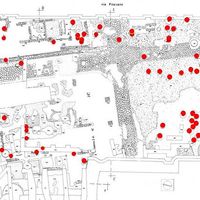 Fig. 1 Archaeological area La Fenice. A secondary crossroad is visible. The burials invaded this area and are distributed throughout the thickness of the layers, proving the cimiterial function for a long period (red dot). A central area free from burials can be noticed: this space can be explained by the presence of a church as the historical sources report, but a localization is not possible. The interpretation is complicated by the fact that this area has undergone several radical interventions, such as the construction of the sixteenth-century walls and the presence of the eighteenth–century theatre La Fenice which was located here until the 1930 earthquake.
Fig. 1 Archaeological area La Fenice. A secondary crossroad is visible. The burials invaded this area and are distributed throughout the thickness of the layers, proving the cimiterial function for a long period (red dot). A central area free from burials can be noticed: this space can be explained by the presence of a church as the historical sources report, but a localization is not possible. The interpretation is complicated by the fact that this area has undergone several radical interventions, such as the construction of the sixteenth-century walls and the presence of the eighteenth–century theatre La Fenice which was located here until the 1930 earthquake.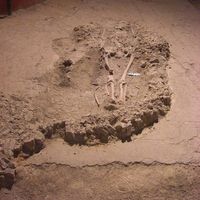 Fig. 2. Tomb 175. This burial cuts the Late Imperial floor. If the anthropological remains will be deemed well preserved, this skeleton will be analyzed with radiocarbon method
Fig. 2. Tomb 175. This burial cuts the Late Imperial floor. If the anthropological remains will be deemed well preserved, this skeleton will be analyzed with radiocarbon method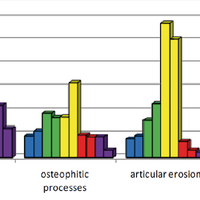 Fig. 4. In relation to the paleopathological outline, it is possible to assert that the examined individuals were in a good state of health for the standards of the age. Periostitis is concentrated on the districts of tibia, femur and humerus. Osteophitic processes and articular erosion are concentrated on the radius and ulna.
Fig. 4. In relation to the paleopathological outline, it is possible to assert that the examined individuals were in a good state of health for the standards of the age. Periostitis is concentrated on the districts of tibia, femur and humerus. Osteophitic processes and articular erosion are concentrated on the radius and ulna.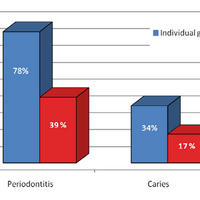 Fig. 5. The etiology of periodontitis is hardly identifiable and different factors cause the inflammation of the gums as for example genetic predisposition, lack of vitamin C or a different amount of sugar in the diet of two groups.
Fig. 5. The etiology of periodontitis is hardly identifiable and different factors cause the inflammation of the gums as for example genetic predisposition, lack of vitamin C or a different amount of sugar in the diet of two groups.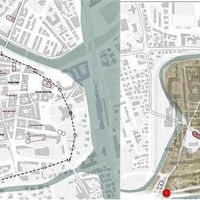 Fig. 6. The formation of two separate zones named civitas (clear area) and civitas vetere (dark area) is showed.
Fig. 6. The formation of two separate zones named civitas (clear area) and civitas vetere (dark area) is showed.
Bibliography
- Acsádi, György, Nemeskéri János. 1970. History of Human Life Span and Mortality. Budapest: Akadémiai Kiadó.
- Alfieri, Nereo. 1981. Le Marche e la fine del mondo antico, in Atti e memorie della Depitazione di Storia Patria per le Marche, 86: 9-34.
- Augenti, Andrea. 2006. ‘Ravenna e Classe: archeologia di due città tra tarda Antichità e l’alto Medioevo’, in Le città italiane tra tarda Antichità e l’alto Medioevo. Atti del convegno (Ravenna, 26-28 febbraio 2004) edited by Andrea Augenti, Firenze, 185-217.
- Barbiera, Irene and Gianpiero Dalla Zuanna. 2007. ‘Le dinamiche della popolazione nell’Italia medievale’, in Archeologia Medievale XXXIV, 19-42.
- Belfiori, Francesco. 2016. ‘Archeologia Urbana a Senigallia. I riti del costruire di Sena Gallica’, in The journal of fasti online: 1-19 [http://fastionline.org/docs/FOLDER-it-2016-369.pdf]
- Bogdani, Julian and Enrico Giorgi. 2010 ‘La conclusione degli scavi nel giardino della domus: le strutture repubblicane, il quartiere termale, la necropoli tarda’ in Archeologia della Valle del Cesano. Da Suasa a Santa Maria in Portuno (Atti del convegno per i venti anni di ricerche dell’Università di Bologna,Castelleone di Suasa, Corinaldo, San Lorenzo in Campo, 18-19 dicembre 2008) edited by Enrico Giorgi and Giusepe Lepore. Bologna: Ante Quem, 335-362.
- Canci, Alessandro and Simona Minozzi. 2015. Archeologia dei resti umani. Roma: Carocci.
- Cantino Wataghin, Gisella and Chiara Lambert. 1998. Sepolture e città. L’Italia settentrionale tra IV e VIII secolo. Atti del VII Seminario sul Tardo Antico e l’Alto Medioevo in Italia centro settentrionale (Gardone Riviera, 24-26 ottobre 1996). Mantova.
- Carra, Maria Letizia and Debora Ferreri. 2014. ‘Analisi bioarcheologiche e attività funerarie presso la basilica di San Severo a Classe: l’area esterna al nartece’, in Ocnus, 22:81-90.
- Cavada Enrico.1998. Cimiteri e sepolture isolate nella città di Trento (secoli V-VIII) in G. Brogiolo- G. Cantino Wataghin, Sepolture tra IV e VIII secolo (7° seminario sul tardo antico e l’alto medioevo in Italia centro settentrionale- Gardone Riviera, 24- 26 Ottobre 1996), Mantova.
- Chavarria Arnau, Alexandra and Federico Giacomello. 2014. ‘Riflessioni sul rapporto tra sepolture e cattedrali nell’alto medioevo’ in HAM, 20, 1: 124-135.
- Crosetto, Alberto.1998. ‘Sepolture ed usi funerari medievali’, in Medioevo edited by Liliana Mercando and Micheletto Egle. Torino: Allemandi, 209-232.
- Duday, Henri 2006. Lezioni di archeotanatologia: archeologia funeraria e antropologia di campo. Roma: Arti Grafiche Mengarelli.
- Ferreri Debora. 2011. ‘Spazi cimiteriali, pratiche funerary e identità nella città di Classe’, in Archeologia Medievale, XXXVIII: 59-74.
- ———. 2014. ‘La città dei vivi e la città dei morti. La ridefinizione degli spazi urbani e le pratiche funerarie a Ravenna e nel territorio circostante tra la tarda antichità e l’alto medioevo’ in HAM 20, 1: 112-123
- ———. 2016. ‘Human remains in archaeology. Excavation, recording and analysis of data: the funerary context of San Severo in Classe’, in Groma, 3: 28-39. DOI: 10.12977/groma5
- Fornaciari, Gino and Vanentina Giuffra. 2009. Lezioni di paleopatologia, Genova: CLU-ECIG.
- Giovannini Fabio. 2001. Natalità, Mortalità E Demografia dell’Italia Medievale sulla Base dei Dati Archeologici. Oxford: British Archaelogical Reports.
- Lambert, C. 1997. ‘Le sepolture in urbe nella norma e nella prassi’, in L’Italia centro-settentrionale in età longobarda, edited by L. Parioli Firenze: 285-293.
- Lepore, Giuseppe. 2013. ‘L’origine della colonia Sena Gallica’, in Epigrafia e Archeologia in territorio marchigiano. Atti del convegno di sstudi, Macerata 22-23 aprile 2013 a cura di Gianfranco Paci. Tivoli 297-322.
- ———. 2014. ‘Il paesaggio urbano di Sena Gallica fra tardo antico e alto medioevo’ in Paesaggi urbani tardoantichi. Casi a confronto, Agrigento (Parco Archeologico “Valle dei Templi”), 29-30 novembre 2014 edited by Maria Concetta Parello e Maria Serena Rizzo, Bari: Edipuglia, 99-107.
- Lepore, Giuseppe, Maria Raffaella Ciuccarelli, Gilda Assenti, Francesco Belfiori, Federica Boschi, Maria Letizia Carra, Tommaso Casci Ceccacci, Mauro De Donatis, Elena Maini, Daniele Savelli, Enrico Ravaioli, Michele Silani, Fabio Visani. 2012 ‘Progetto “Archeologia Urbana a Senigallia” I:le ricerche di via Cavallotti’, in The journal of fasti online: 1-19 [http://www.fastionline.org/docs/FOLDER-it-2012-248.pdf]
- Lepore, Giuseppe, Giuliano De Marinis, Francesco Belfiori, Federica Boschi, Michele Silani. 2012b. ‘Progetto “Archeologia Urbana a Senigallia” II:le ricerche di via Baroccio e di via Gherardi’, in The journal of fasti online, 265: 1-30 [http://www.fastionline.org/docs/FOLDER-it-2014-265.pdf].
- Lepore, Giuseppe, Emanuele Mandolini, Michele Silani, Belfiori Francesco, Galazzi Federica. 2014. ‘Archeologia Urbana a Senigallia III: i nuovi dati dall’area archeologica “La Fenice”’, in The journal of fasti online, 308: 1-32 [http://www.fastionline.org/docs/FOLDER-it-2014-308.pdf].
- Lovejoy, C. Owen. 1985. ‘Dental wear in libben Population: its functional patter and role in the determination of adult skeletal age at the death’ in American Journal of physical anthropology 68: 47-56.
- Mesturini, Marco. 2016. La città e le mura di Senigallia nel corso dei secoli: analisi e proposta di valorizzazione. Tesi triennale di laurea 2015/2016. Dipartimento Politecnico di Ingegneria e Architettura. Corso di Laurea in Architettura. Università degli studi di Udine. Udine.
- Profumo, Maria Cecilia. 1997. ‘Archeologia funeraria e insediamenti nelle Marche nei secoli VI e VII’, in L’Italia centro-settentrionale in età longobarda edited by L. Paroli. Firenze, 55-76.
- Salvini, Monica. 2003. Area Archeologica e Museo La Fenice. Guida. Senigallia: Soprintendenza per i Beni archeologici delle Marche.
- Scheuer Louise, Sue Black and Maureen Schaefer, Juvenile Osteology , Amsterdam: Elsevier.
- Silani, Michele Mauro De Donatis, Daniele Savelli, Federica Boschi, Giuseppe Lepore, Sara Susini. 2016. ‘Geo-archaeology of the Roman palaeosurface of Sena Gallica (Senigallia, Italy)’, in Journal of Maps, 12, 5: 1206-1211.
- Ubelaker Douglas, H. Hubelaker. 1989. Human Skeletal Remains: Excavation, Analysis, Interpretation. Washington, DC: Taraxacum.
- Vico, Roberta. 2015. Cambiamenti nel paesaggio urbano e nel territorio di età post classica nei centri interni dell’Ager Gallicus. Tesi di laurea in Archeologia della città romana, Corso di laurea magistrale in Ricerca, documentazione e tutela dei Beni Archeologici. Ravenna.
- Villani, Virginio. 2008. Senigallia medievale. Vicende politiche e urbanistiche dall’età comunale all’età malatestiana. Secoli XII-XV. Senigallia: Provincia di Ancona e Comune di Senigallia.
- White Timothy Douglas and Pieter A. Folkens. 2005. The Human Bone Manual. Oxford:Elsevier.